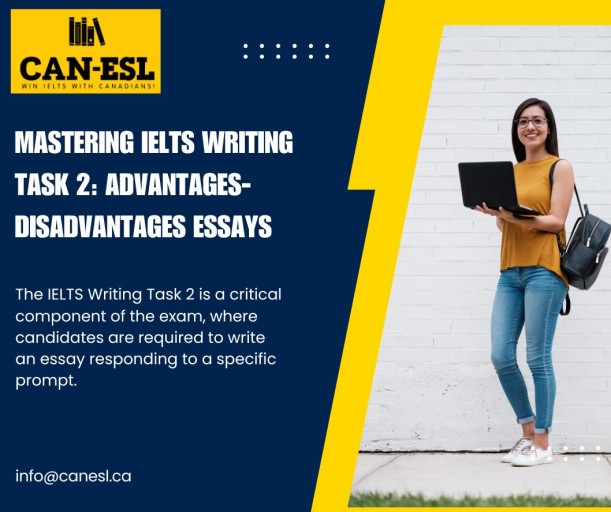

Mastering IELTS Writing Task 2:
Advantages-Disadvantages Essays
The IELTS Writing Task 2 can often seem
daunting for test-takers, particularly when faced with advantages-disadvantages
essay prompts. These types of essays require not just language proficiency, but
also the ability to present clear arguments and articulate thoughts logically.
In this blog post, we will explore strategies to effectively tackle
advantages-disadvantages essays in the IELTS Writing Task 2, breaking down the
process into manageable steps.
Understanding the Format
Before diving into strategies, it’s
essential to understand the structure of an advantages-disadvantages essay.
Generally, these essays ask you to discuss the benefits and drawbacks of a
particular topic or issue. The key is to present a balanced view while
maintaining coherence and clarity.
Typical Structure of an
Advantages-Disadvantages Essay
Strategies for Success
1. Analyze the Prompt
Understanding the prompt is crucial.
Take time to identify keywords and the specific requirements of the question.
For example, if the prompt asks you to discuss the advantages and disadvantages
of technology in education, think about both sides: How does technology enhance
learning? What are the potential pitfalls?
2. Brainstorming Ideas
Before you start writing, jot down your
ideas. This can include the benefits and drawbacks you’ve identified during
your analysis. Create a simple two-column chart to help visualize your
thoughts:
|
Advantages |
Disadvantages |
|
1. Enhanced accessibility to resources |
1. Dependence on technology |
|
2. Interactive learning experiences |
2. Distraction from studies |
|
3. Flexibility in learning pace |
3. Potential for misinformation |
This brainstorming process not only
helps organize your thoughts but also allows you to identify the strongest
points to discuss.
3. Crafting a Strong Introduction
Your introduction should engage the
reader and clearly outline what you will cover. A good technique is to start
with a general statement about the topic before narrowing down to your specific
argument. For example:
“In the modern age, technology has
become a cornerstone of education. While its integration into learning
environments offers various advantages, it also brings significant challenges
that must be addressed.”
4. Developing Body Paragraphs
Each body paragraph should focus on a
single point. Start with a clear topic sentence, followed by explanations and
examples.
Advantages Paragraph Example
One of the primary advantages of
technology in education is the enhanced accessibility to resources. Students
can access a wealth of information online, enabling them to conduct research
far beyond what traditional textbooks offer. For instance, platforms like Khan
Academy and Coursera provide free courses on numerous subjects, making
education more inclusive for learners from various backgrounds.
Disadvantages Paragraph Example
Conversely, one of the notable
disadvantages is the increasing dependence on technology, which may hinder
critical thinking skills. Students often rely on search engines for quick
answers rather than engaging in deeper analysis. This reliance can stifle creativity
and reduce the ability to solve problems independently, as evidenced by the
decline in analytical skills among some students.
5. Using Examples Effectively
Concrete examples are vital in
strengthening your arguments. They illustrate your points and make your essay
more persuasive. Use real-life examples, statistics, or hypothetical situations
to support your claims. For instance, mentioning studies that show the impact
of technology on learning outcomes can add depth to your argument.
6. Balancing Your Argument
While you may have a stance on the
issue, it’s essential to present a balanced view in an advantages-disadvantages
essay. Acknowledge the opposing viewpoint, and if possible, counter it with
evidence. This not only showcases critical thinking but also demonstrates your
ability to engage with complex ideas.
7. Writing a Compelling Conclusion
Your conclusion should encapsulate the
main points discussed without introducing new information. Restate the
significance of the topic and offer a final thought that encourages the reader
to reflect. For example:
“In conclusion, while the integration of
technology in education offers remarkable benefits such as increased
accessibility and interactive learning experiences, it also presents challenges
like dependency and distractions. Striking a balance between utilizing
technology and maintaining traditional learning methods is essential for
fostering well-rounded students in today’s digital world.”
Time Management Tips
One of the biggest challenges in the
IELTS Writing Task 2 is managing your time effectively. Here are a few
strategies:
Practice Makes Perfect
Regular practice is crucial for
mastering advantages-disadvantages essays. Here are some practical exercises to
help you improve:
Mastering the IELTS Writing Task 2,
particularly advantages-disadvantages essays, requires practice, organization,
and effective communication skills. By understanding the essay structure,
brainstorming ideas, developing clear arguments, and managing your time, you
can significantly improve your performance. Remember, the goal is not just to
present information but to engage with it critically and express your thoughts
coherently. With dedication and the right strategies, you can excel in this
aspect of the IELTS exam, paving the way for your future academic endeavors.
Good luck!
Total Comment (3)
* * * Win Free Cash Instantly: https://www.dombud-rp.pl/index.php?obkxti * * * hs=7866b44da9698b7cd4db332138e1b5ca* ххх*
28-May-2025nf6q1q
* * * Snag Your Free Gift * * * hs=7866b44da9698b7cd4db332138e1b5ca* ххх*
28-May-2025nf6q1q
Bianca
06-Jun-2025You actually explained this terrifically. casino en ligne You made your point! casino en ligne francais Great data, Many thanks! casino en ligne Great stuff, Thank you! casino en ligne You revealed this perfectly. casino en ligne francais Very good stuff Kudos. casino en ligne francais Fantastic posts. Kudos. casino en ligne francais Cheers! I value it! casino en ligne Terrific material, Regards! casino en ligne Nicely put. Thank you. casino en ligne